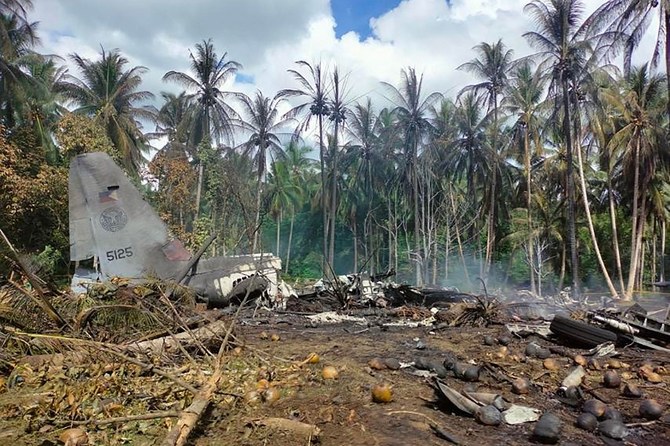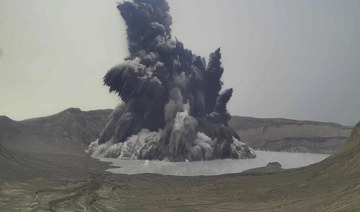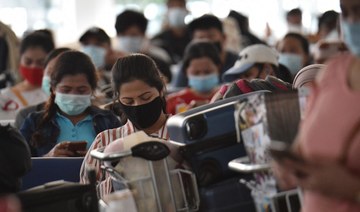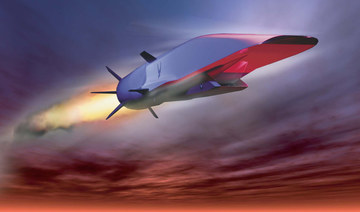MANILA: At least 45 people were killed on Sunday after the military’s C-130H Hercules transport aircraft crashed on landing in the southern Philippines, the Armed Forces of the Philippines (AFP) said.
“The aircraft was transporting our troops from Laguindingan Airport in Cagayan to Jolo when it crashed at Barangay Bangkal, Patikul, Sulu just a few kilometers east of Jolo airport,” Armed Forces Chief of Staff Gen. Cirilito Sobejana told Arab News.
“We are currently attending to the survivors who were immediately brought to the 11th Infantry Division station hospital in Busbus, Jolo, Sulu,” he said.
Initial information released to the media indicated that there were 96 people on board, mostly army troops, five crewmen and three pilots, while images and videos shared by residents in the area showed thick black smoke billowing from the crash site.
Five military personnel remain unaccounted for, the defence ministry said.
The death toll includes three civilians who were killed on the ground. Forty-nine military personnel and four civilians were also injured and taken to hospital.
Another statement from the Air Force said the C130 plane took off from the Col. Jesus Villamor Air Base in Pasay City, Metro Manila, toward Lumbia Airport in Cagayan de Oro, to pick up troops for duty in Jolo.
An Arab News source said, “sketchy reports” showed that the C-130 “overshot the runway” at the Jolo airport as it attempted to land.
“It was reported to have bounced, skidded and hit the end wall or the hillside,” he added.
Another official who requested anonymity as he was not authorized to speak to the media said that the “C-130 broke into two and burned.”
The air force has also informed Defense Secretary Delfin Lorenzana that they were “pulling small aircraft and helicopters to Zamboanga and Jolo to help evacuation.”
Sobejana told reporters that the aircraft was “trying to regain the power to make another attempt to land” after it missed the runway “but failed and ended up crashing in Barangay Bangkal, Patikul, Sulu.”
Joint Task Force Sulu commander, Major Gen. William Gonzales, said that the passengers included new army privates en route to Sulu to fight terrorism in the area.
“We remain hopeful that we can find more survivors. Our search and rescue is still ongoing with 17 personnel unaccounted for,” Gonzales said. “These individuals were supposed to report to their battalions today. They were supposed to join us in our fight against terrorism.”
“This is a sad day, but we have to remain hopeful. We enjoin the nation to pray for those who are injured and those who have perished in this tragedy,” he said.
Citing witnesses’ accounts, Gonzales said that “a number of soldiers were seen jumping out of the aircraft before it hit the ground, sparing them from the explosion caused by the crash.”
He added that minutes after the crash, troops and civilian volunteers rushed to the site to rescue people.
Malacanang, in a statement released by President Rodrigo Duterte’s spokesperson, Harry Roque, said: “We are saddened by the C-130 mishap in Sulu. Rescue efforts are ongoing, and we are one in praying for the safe recovery of the passengers.”
Lorenzana called on the public to refrain from spreading “highly speculative statements” about the incident. This followed allegations of defective equipment being purchased and used by the AFP.
“We are currently focusing our attention on the rescue of the survivors of the C-130 crash, and all available resources of the AFP are being utilized for ongoing search and retrieval operations,” he told reporters.
“With the investigations of the past mishaps still ongoing, such speculations are as of yet baseless and disrespectful to the affected women of the Philippine Air Force, AFP and their families,” he said.
Questions about the quality of equipment purchased by the AFP surfaced anew as the C-130 crash occurred less than two weeks after a newly acquired S-70i Black Hawk utility helicopter of the Air Force crashed during a night flight training in Tarlac province in the island of Luzon, killing all six people on board.
The ill-fated transport plane was one of the two C-130H aircraft acquired by the AFP from the US government through the Defense Security Cooperation Agency. It arrived in the country last Jan. 29 and was formally inducted into the PAF fleet during ceremonies at the Villamor Air Base on Feb. 18.
The cost of acquiring the two C-130H aircraft was earlier placed at P2.5 billion, with the Philippines contributing P1.6 billion and the US about P900 million.
Capable of using unprepared runways for takeoffs and landings, the four-engine C-130 was initially designed as a troop, medical evacuation and cargo transport aircraft.
The military, meanwhile, said that an investigation would be conducted to determine the cause of the C-130 crash.
A senior defense official, responding to questions from Arab News, said among the angles that will be looked at are “human error.”
Asked if the aircraft may have been targeted from the ground, the official, who asked not to be named, said, “That’s a possibility, but we do not want to speculate.”
“Usually our pilots are very wary when they approach and take off from there because once you leave the perimeter of the airfield, you’re in a no man’s land because many of our aircraft, particularly Huey helicopters, are being fired upon while passing that air space,” the source said.
Jolo province is considered a hotbed of the Daesh-inspired Abu Sayyaf Group (ASG).
“But based on the circumstances of the incident, pilot error could not be ruled out,” the source said.
The US, through its embassy in Manila, offered condolences to the families of the crash victims and said that it was assisting the DND in extending medical support.
“We offer our sincerest condolences to the families of those who passed away in the crash in Sulu. The US Embassy is assisting @dndphl in providing medical support and stands ready to provide further assistance,” US Embassy Chargé d’Affaires John Law said on Twitter.

































